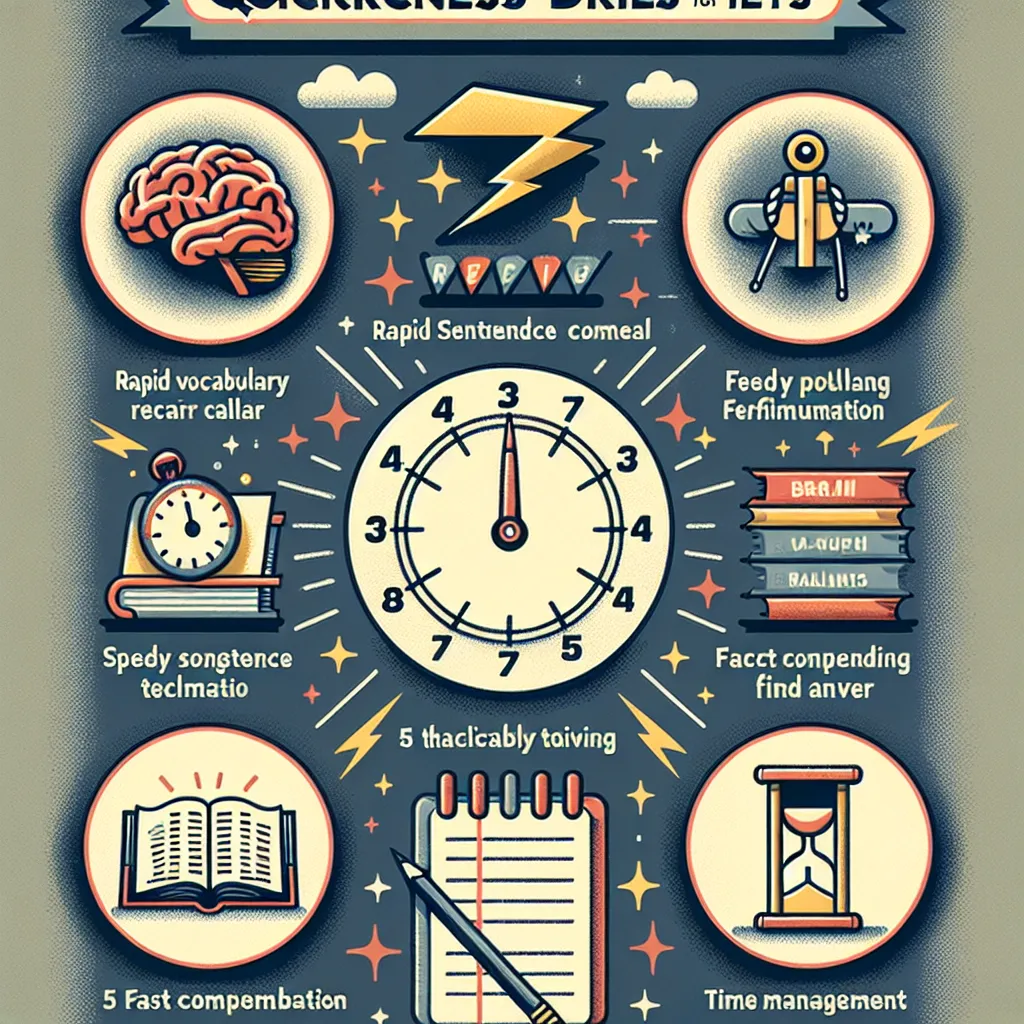Quickness drills are essential exercises designed to enhance your speed and accuracy in various aspects of language learning, particularly beneficial for IELTS preparation. These drills focus on rapid recall and application of vocabulary, grammar, and comprehension skills. Let’s explore how mastering quickness drills can significantly improve your IELTS performance.
Understanding Quickness Drills
Quickness drills, in the context of IELTS preparation, are short, intense exercises that train your brain to process and respond to English language stimuli rapidly. These drills are crucial for developing the agility needed to excel in time-pressured sections of the IELTS exam.
Key Components of Quickness Drills
- Rapid Vocabulary Recall: Quickly identifying and using appropriate words.
- Speedy Sentence Formation: Constructing grammatically correct sentences swiftly.
- Quick Comprehension: Rapidly understanding written or spoken information.
- Fast Problem-Solving: Making quick decisions in language-based tasks.
- Time Management: Improving overall speed in exam conditions.

Benefits of Quickness Drills for IELTS
Incorporating quickness drills into your IELTS preparation routine offers numerous advantages:
-
Enhanced Reading Speed: Improves your ability to skim and scan texts quickly, crucial for the IELTS Reading section.
Example: In a timed reading exercise, practice identifying key information in a complex academic text within 2 minutes. This quickness drill helps in rapidly locating specific details.
-
Improved Listening Skills: Sharpens your ability to catch information in fast-paced conversations or lectures.
Example: Listen to a 30-second news clip and immediately answer questions about its content. This quickness drill enhances your ability to process spoken information rapidly.
-
Faster Writing Response: Helps in quickly organizing thoughts and writing coherent answers.
Example: Practice writing a well-structured paragraph on a given topic in just 3 minutes. This quickness drill improves your ability to formulate ideas and express them swiftly.
-
Enhanced Speaking Fluency: Develops your ability to respond promptly and coherently in the Speaking test.
Example: Answer impromptu questions on various topics within 30 seconds each. This quickness drill boosts your ability to think and speak spontaneously.
-
Improved Time Management: Enhances overall efficiency in completing tasks within the allocated time.
Example: Complete a mock IELTS Writing Task 1 in 15 minutes instead of the usual 20. This quickness drill helps in managing time more effectively during the actual test.
Effective Quickness Drill Techniques
To maximize the benefits of quickness drills, consider these techniques:
1. Timed Vocabulary Exercises
Set a timer for 1 minute and write down as many words as you can related to a specific theme (e.g., environment, technology). This quickness drill enhances vocabulary recall and mental agility.
Example:
Theme: Technology
Words: computer, smartphone, algorithm, artificial intelligence, software, hardware, network, cybersecurity, innovation, digital
2. Rapid Reading Comprehension
Practice reading short passages (150-200 words) and answering comprehension questions within strict time limits. Start with 3 minutes and gradually reduce the time to 2 minutes.
Example:
Read a 200-word text about climate change and answer 3 questions in 2 minutes. This quickness drill improves reading speed and information processing.
3. Quick Response Speaking Drills
Use IELTS speaking cue cards and give yourself just 30 seconds to prepare before speaking for 1 minute on the topic. This drill enhances quick thinking and speaking fluency.
Example:
Topic: Describe a memorable journey you’ve taken.
Preparation time: 30 seconds
Speaking time: 1 minute
4. Speed Writing Challenges
Practice writing short essays or reports on random topics with increasingly shorter time limits. Start with 20 minutes and work your way down to 15 minutes for a 250-word piece.
Example:
Write a 250-word essay on the pros and cons of social media in 15 minutes. This quickness drill improves writing speed and coherence under time pressure.
5. Rapid Listening and Note-Taking
Listen to short audio clips (1-2 minutes) and take notes simultaneously. Then, answer questions based on your notes within 30 seconds.
Example:
Listen to a 90-second lecture on renewable energy, take notes, and answer 3 questions in 30 seconds. This quickness drill enhances listening comprehension and note-taking skills.
Integrating Quickness Drills into Your IELTS Preparation
To effectively incorporate quickness drills into your IELTS study plan:
- Start Slow: Begin with longer time limits and gradually reduce them as you improve.
- Consistency is Key: Practice quickness drills daily, even if just for 10-15 minutes.
- Track Progress: Keep a log of your performance in each drill to monitor improvement.
- Vary Drill Types: Rotate between different types of drills to cover all IELTS skills.
- Simulate Test Conditions: Occasionally combine different drills to mimic actual test scenarios.
Common Mistakes to Avoid in Quickness Drills
While practicing quickness drills, be wary of these common pitfalls:
- Sacrificing Accuracy for Speed: Always prioritize correctness over speed.
- Neglecting Review: Take time to analyze mistakes after each drill.
- Overexertion: Balance intense drills with regular study methods to prevent burnout.
- Ignoring Weak Areas: Focus on improving your weakest skills, not just practicing what you’re good at.
- Lack of Real-Test Application: Ensure you apply the speed gained in drills to full-length practice tests.
Conclusion
Mastering quickness drills is a powerful strategy to enhance your IELTS performance. By improving your speed and accuracy across all language skills, you’ll be better equipped to handle the time pressures of the IELTS exam. Remember, consistent practice with these drills, combined with a balanced study approach, will lead to significant improvements in your IELTS scores.
Start incorporating these quickness drills into your daily IELTS preparation routine and watch your speed, confidence, and overall performance soar. Don’t forget to share your experiences and any questions about these techniques in the comments section below. Good luck with your IELTS journey!